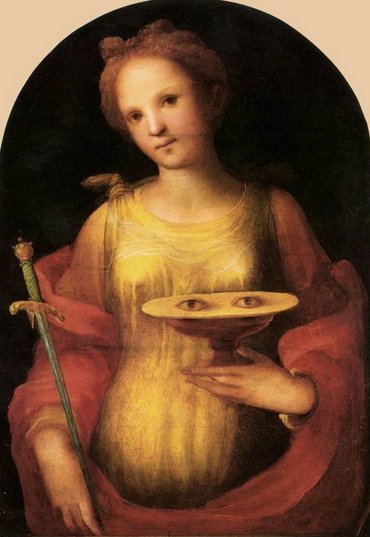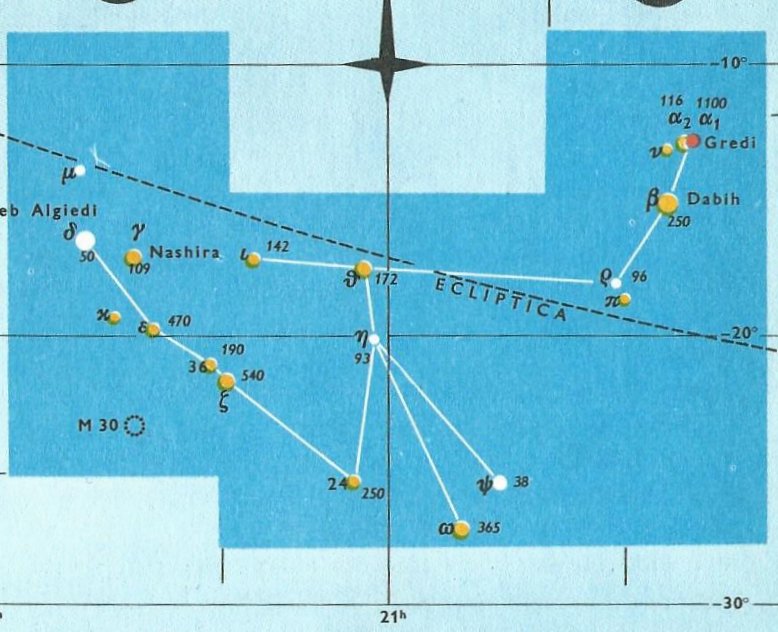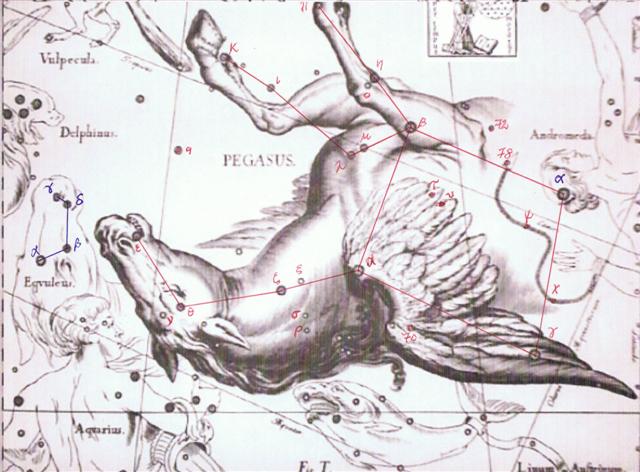Once again. Given 1 glyph per right ascension day,
 |
29 |
 |
10 |
 |
3 |
 |
17 |
 |
255 |
 |
|
Gb6-26
(408) |
Gb7-28
(438) |
Gb8-8 |
Gb8-12 |
Gb8-30
(471) |
Gb2-1
(256) |
|
Sirrah (0h) |
Hamal |
Bharani |
Algol (*45) |
Hyadum I |
Dramasa |
|
64 |
256 (= 4 * 64) |
it is possible to see the similarity between the pair of
glyphs Ga1-4 and Ga7-16 as a reference to Aldebaran and Antares:
|
 |
33
|
no glyph |
3 |
 |
180 |
 |
70 |
 |
|
Gb7-28 |
Ga1-4 |
Ga7-16 (185) |
Gb2-1 (256) |
|
Hamal |
Hyadum II
(*64) |
Aldebaran
(*68) |
Antares
(*249) |
Dramasa
(*320) |
|
April 20 (110) |
May 24 (144) |
May 28 (148) |
Nov 25 (329) |
Febr 4 (400) |
|
290 |
And then, from the fact that Antares was rising with the Sun in day 329
(according to the time-frame of rongorongo) we can see that
we have to move 329 (November 25) - 288 = 41 precessional right ascension
days back into ancient times in order to find the date
te angahuru marima o te raa.o tangaroa uri
("October 15).
Because on Easter Island the 10th month was
Tagaroa uri and this
month meant October.
... The ancient names of the month were: Tua haro,
Tehetu'upú, Tarahao, Vaitu nui, Vaitu potu, He Maro, He
Anakena, Hora iti, Hora nui, Tagaroa uri, Ko Ruti, Ko Koró.
... On the fifteenth day of the month of
October (tangaroa uri), Nonoma left the house [he
ea mai roto i te hare] during the night [i te po]
to urinate outdoors [ki kaho.mimi]. At this
point Ira called out [he rangi] to Nonoma, 'Look at
the canoe!'
Nonoma ran [he tahuti], he quickly went to Te Hiringa
Heru (a ravine in the side of the crater Rano Kau) and
looked around. There he saw the double canoe way out near
the (offshore) islets [i te motu o haho], and the two
(hulls of the canoe) were lashed together.
He ran and returned [he tahuti he hoki]
to the front of the house [ki te mua ki te hare].
He arrived and called [he tuu he rangi] into the
house [a roto i te hare], 'Hey you! This canoe has
arrived during the night without our noticing it!' [E:75]
Thus the time-frame of Manuscript E was that of Bharani (*41
= 329 - 288):
 |
22 |
no glyph |
3 |
 |
180 |
 |
70 |
 |
|
Gb8-8 (449) |
Ga1-4 |
Ga7-16 (185) |
Gb2-1 (256) |
|
Bharani
(*41) |
Hyadum II
(*64) |
Aldebaran
(*68) |
Antares
(*249) |
Dramasa
(*320) |
|
May 1 (121) |
May 24 (144) |
May 28 (148) |
Nov 25 (329) |
Febr 4 (400) |
|
"March 21 (80) |
"April 13 (103) |
"April 17 (107) |
"Oct 15 (288) |
"Dec 25 (359) |
From my suggestion that king Oto Uta was a name for
Hamal it here becomes understandable why king Hotu A Matua
might have been worried about the image - 'stone figure', moai maea
-
of this his primary ancestor (who had been left out in the water of the
bay of Hanga Moria One
in Hiva), for 'dry
land' could not arrive until Bharani rose with the Sun (at the
beginning of the Sun calendar).
... Hotu said [he ki a Hotu] to
Pure O [Ō], to Pure Ki, and to Pure Vanangananga: 'You
fellows (kope), sail [ko oho.korua ko nga kope]
to the friend (hoou), to Oto Uta.
Bring him here [ka too mai], he
who is resting out there in the bay [i mua.i te hanga].
Move him carefully (? nee), you fellows, so that the
king, that Oto Uta is not damaged!'
[E:87]
Lots of circumstantial evidence support my interpretation.
For instance: 288 = 2 * 144 = 3 * 96 = 4 * 72 = 6 * 48 = 8 *
36 = 12 * 24 = 16 * 18. When the Pope Gregory
XIII launched his updated version of the Julian calendar also
he had chosen day number 288:
... The Julian calendar day Thursday, 4
October 1582 was followed by the first day of the Gregorian
calendar, Friday, 15 October 1582 (the cycle of weekdays was
not affected) ...
Extrapolating beyond Dramasa at the south pole we will find the Chinese
Rooftop (at the Lucky King Sadalmelik) 14 days later:
 |
22 |
no glyph |
3 |
 |
180 |
 |
70 |
 |
10 |
|
Gb8-8 (449) |
Ga1-4 |
Ga7-16 (185) |
Gb2-1 (256) |
|
Bharani (*41) |
Hyadum II (*64) |
Aldebaran (*68) |
Antares (*249) |
Dramasa (*320) |
|
May 1 (121) |
May 24 (144) |
May 28 (148) |
Nov 25 (329) |
Febr 4 (400) |
|
"March 21 (80) |
"April 13 (103) |
"April 17 (107) |
"Oct 15 (288) |
"Dec 25
(359) |
|
280 |
|
LUCIA |
DEC
14
(12 * 29 = 348) |
15 |
16 (*270
= 3 * 90) |
17 |
 |
 |
 |
 |
 |
 |
|
Gb2-12 |
Gb2-13 |
Gb2-14
(40) |
Gb2-15
(270) |
Gb2-16 |
|
KUH (Weeping)
=
μ
Capricorni
(331.4),
γ
Gruis (331.5)
*290.0 = *331.4 - *41.4 |
no star listed (332) |
η Piscis Austrini
(333.4)
*292.0 = *333.4 - *41.4 |
22h (334.8)
KAE UH
(Roof) = ο Aquarii
(334.0),
AL KURHAH (White Spot) = ξ Cephei
(334.4),
SADALMELIK
(Lucky King)
= α Aquarii,
AL
DHANAB
(The Tail)
= λ Gruis
(334.6), ι Aquarii, ν Pegasi (334.7)
*293.0 = *334.4 - *41.4 |
ι Pegasi (335.0),
ALNAIR (The Bright One) = α Gruis
(335.1), μ Piscis Austrini, υ Piscis Austrini
(335.3),
WOO (Pestle)
= π Pegasi
(335.7),
BAHAM = θ Pegasi,
τ Piscis Austrini (335.8) |
 |
|
Febr 15 |
16 |
17 (413 = 14 * 29½) |
18 (364 + 50) |
19 (50) |
|
°Febr 11 |
12 (408) |
13 (364
+ 45 |
2-14 |
15 (46) |
|
'Jan 19
(384) |
20 |
21 (364
+ 32) |
22 |
23
(*308) |
|
"Jan 5 |
6 |
7 (364 +
8) |
8 (*293) |
9 |
|
...
Originally the highly born family
of the Sun, Moon, and stars dwelt in a cave on the
summit of Maunga-nui, Great Mountain, in the
ancient homeland. They were not at all comfortable
in their gloomy home for they could not see
distinctly and their eyes watered constantly ...
... When it was evident that the
years lay ready to burst into life, everyone took
hold of them, so that once more would start forth -
once again - another (period of) fifty-two years.
Then (the two cycles) might proceed to reach one
hundred and four years. It was called 'One Age' when
twice they had made the round, when twice the times
of binding the years had come together. Behold what
was done when the years were bound - when was
reached the time when they were to draw the new
fire, when now its count was accomplished. First
they put out fires everywhere in the country round.
And the statues, hewn in either wood or stone, kept
in each man's home and regarded as gods, were all
cast into the water.
Also (were) these (cast away) - the pestles and the
(three) hearth stones (upon which the cooking pots
rested); and everywhere there was much sweeping -
there was sweeping very clear. Rubbish was thrown
out; none lay in any of the houses ...
... It must be admitted, however, that the task of
raising the sky was not always a long and arduous
one. In the New Hebrides of Melanesia the sky was
formerly so low overhead that a woman who was
pounding roots in a mortar happened to strike the
sky with her pestle. Greatly annoyed at the
interruption she looked up and cried angrily, 'Go on
up higher!' Whereat the sky meekly obeyed her. What
actually happened probably was that the woman struck
the low house roof with her pestle and cried angrily
to her husband, 'If you don't raise that roof
higher, I won't cook you another meal!' thus giving
a strong impuls to the development of the science of
architecture ...
 |







